
|   |

|   |
 e-mail: leelakaverivenkat@gmail.com Dance theatre with confluence of dance traditions October 21, 2017 Female dance traditions of Kerala in Sita Sambhashanam At the Kamaladevi Chattopadhyay hall of the IIC, Bharati Shivaji's Mohiniattam Collective presented Sita Sambhashanam on Sept 27 in a confluence of female dance traditions of Kerala, namely Mohiniattam, Nangiarkoothu and Kathakali stree vesham. The presentation of each form was based on sahitya in a different language - Avadhi for the Mohiniattam segment, Sanskrit for the Nangiarkoothu part and Manipravalam for the Kathakali section. The Avadhi script by Mohan Maharishi had music set by Yatindra Sharma. The presentation began with Bharati Shivaji as desolate Sita agonising over the tragedy of her beloved husband (Hamare prabhu Ram) being lured away from his forest dwelling followed by his brother, leaving wife Sita unattended for Durachar Ravan's evil deed of apaharan (abduction). To the mnemonics of the edakka enters Mandodari enacted by Kalamandalam Anil Kumar in stree vesham. Seeing Sita shrinking away from her, Mandodari allays her fears with the music in a pleading Varali as she shows her complete sympathy for Sita's plight. She also expresses her fears for what Ravana's very unjust act, prompted by Shoorpanakha whose ghor aparada (misdeed), portends for the future of Lanka and Ravana's clan. 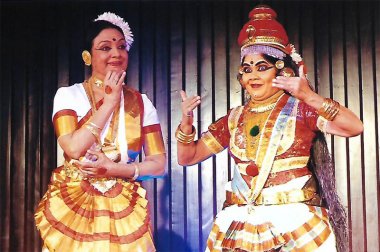 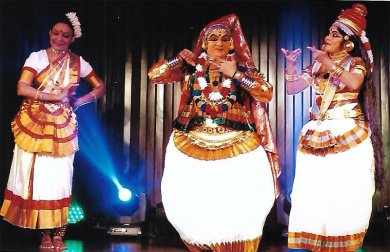
As Sita begins to relax knowing that she is not in the midst of an enemy, Shoorpanakha (portrayed by Girijadevi, the Nangiarkoothu expert) enters, smouldering with rage for what she believes is injustice meted out to her, driving away Mandodari. The Dhanyasi raga now changes to Mohanam as the demon questioned by Sita, enacts how she was humiliated, with her declaration of love for the two Ayodhya princes repudiated and mocked at, with Lakshman finally disfiguring her by cutting off her nose. "Kitana dandu" (how much punishment) says Sita telling her that Rama compelled to exile by Kaikeyi was now even separated from his wife. "You do not know what love is. Kshama kar sikho," (learn to forgive) says Sita referring to fondness and compassion as the adornment of a woman. Girijadevi's mukhabhinaya had all the subtlety and range that Nangiarkoothu is known for, the initial thirst for revenge so strongly reflected on her face changing to one of remorse and atonement, as Shoorpanakha makes up her mind to cleanse herself in the ocean and embrace Mother Nature. Providing the pulse and tempo and emotive underpinnings for the part was the mizhavu percussion, with the music having only the recited Sanskrit with no melody. While the sahitya for Kathakali and Nangiarkoothu, had the traditional feel, the flat Avadhi to which Bharati did her abhinaya, while full of this dancer's customary grace, fell short of portraying the full enchantment of Mohiniattam. And ultimately, urging Shoorpanakha to forgive and forget what she had gone through, (particularly when viewed against this day and age with so much being said about woman power), sounded a little preachy and difficult to accept. Powerful theatre by Rasa United 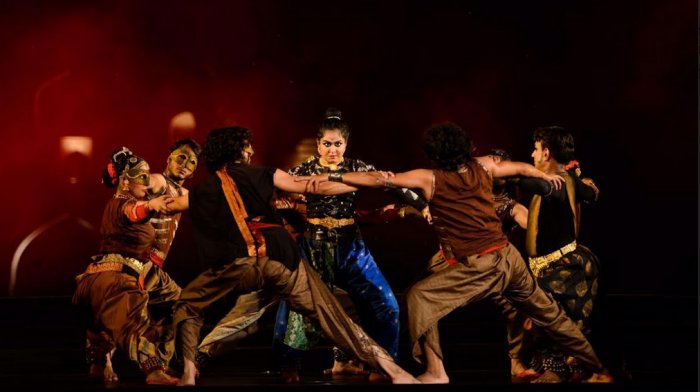 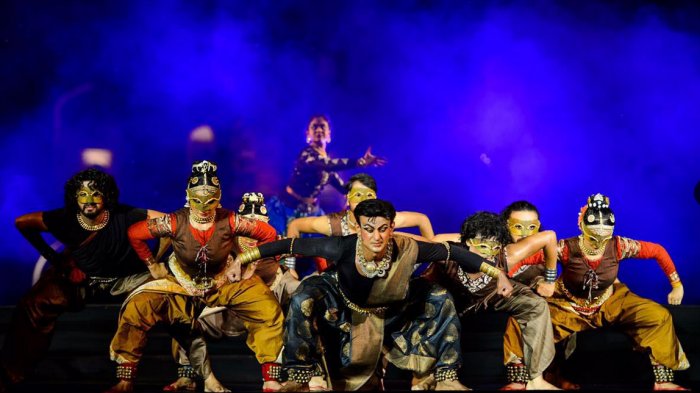 Photos: Parthiv Goel Yet another very powerful presentation based on a confluence of dance forms was on the concluding event of the Purana Qila festival of Choreographies on Indian dance mounted by the Sahitya Kala Parishad in conjunction with the Department of Art, Culture and languages, Government of Delhi with Dramatic Tales spearheaded by Kuchipudi dancer Vanashree Rao and presented by Rasa United, her recently set up group. In a tight very professionally designed programme, what was very evident right through was the coordination existing amongst like minded young people representing different disciplines of dance and music, who constitute this group, with the lead provided by Vanashree - whose talents have been honed under Gurus Krishna Kumar, husband Jaya Rama Rao, Guru Vempati Chinna Satyam and Guru Nataraja Ramakrishna. With a combination of representatives from Chhau, Bharatanatyam and Kuchipudi, what ultimately emerged was a power packed presentation, with audience attention held spellbound from start to finish. The starting Tripurasura introduced the three demons, all nimble Chhau dancers in a three cornered presentation, solo and group formations of well held asana freezes (which also are part of the bandhas or acrobatics Odisha forms like Gotipua are known for) revelling in giving out the message of power, culminating in the Hathyadhara sword and shield movements of Chhau. The imposing music for the entire show devised under Vanashree's guidance by composers and vocalists Vasudevan and Venkateshwar, had the most amazing percussion interventions covering all moods, by Tanjavur Keshavan wielding a variety of percussion instruments. Shiva destroying the three demons was a quick scene, the music in a heralding tone of Hamsadhwani and Revati. The next dramatic number based on Sanskrti text "Saurashtre Somanatham cha Sreesaile Mallikaarjune Ujjainyaam Mahakalam Omkaramamaleswaram....." was woven round the 12 Jyotir Lingams of Shiva, sites spread all over the country, each worshipped for a particular aspect of the Shiva lore. This was a unique composition, given a very crisp presentation with no time to dawdle over any point while covering the following manifestations of the Jyotirlinga- Somnath, Mallikarjuna, Mahakaleswar - Omrakeswar, Vaidyanath, Bhimashankaram, Rameshwar and the Dwaadasha Jyotirlingas - Nageshwa Kashi Vishwanath, Triyambakeshwar, Kedarnath and Ghrishneshwar. The fleeting imagery with the musical effects effectively painted in the mind's eye a geographical picture of the area where each temple is housed - on a mountain or by the sea. Yama is visualised in a quick caper of death before spreading the noose round Markandeya. With the kind of lighting effects by Sharad Kulashreshta, the visual imagery was an experience, evoking that heightened feel of entering a space outside of what mundane everyday life can offer. The item was rounded off with a final homage to Shiva, based on the Rudra Chamakam chanting of the epithets applied to the Lord - altogether a compelling dance narrative! And what a persuasive dancer Vasudevan has turned out to be! He would seem to have found his medium. As a solo Bharatanatyam dancer, he would have been one of many. But given his fine stage presence, musical acumen combining singing, composing and authoritative nattuvangam, with the proven ability to make very impactful interventions in various roles (as Yama, Shiva and Karna) - all add up to making him a powerful asset in such group presentations. 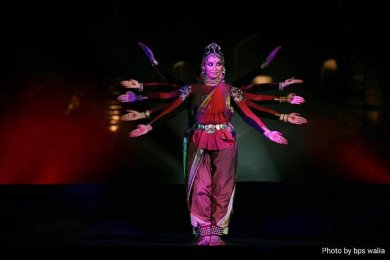 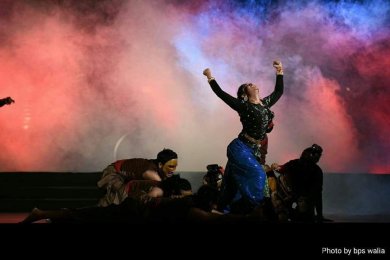 Photos: BPS Walia The next tale of Abhimanyu Vadh Drona Parv was another highly nuanced theatrical presentation drawing on the pathos of the Mahabharata episode. The scene capturing young loving couple Subhadra now with child, and Arjuna (enacted by Gulbin Sultana and Kuleshwar Kumar) had a tenderness and sensitivity with the music in Kurinji, a raga meant for auspicious occasions, with the accompaniments too in tune with this mood. The music changes to Arabhi as Subhadra is listening to her husband Arjuna recounting the art of entering the chakravyuha war formation. The child in the womb absorbs this knowhow but is ignorant on how to escape out of this, for Subhadra had fallen asleep while Arjuna described the escape part. The war scene was skilfully designed step by step, as a challenged Abhimanyu in the vortex of battle is trapped in Dronacharya's machinations, lured into the chakravyuha. The high tone physicality and drive of the whole scene said much for the fitness levels of the participants. The drum sounds building up to war frenzy until the final mangling of the very brave Abhimanyu made for a very moving scene. The concluding Mahishasura Mardini again was a tight well knit presentation with Vanashree appearing as the vanquishing Devi. The young Kuchipudi disciples of Vanashree are emerging as very promising dancers. And costumes with Sandhya Raman and Vanashree's own designs were eye catching. Chhau dancers Kuleshwar, Prashant, Arjun, Deepak and Mahesh, Kuchipudi performers Ayana Mukherjee, Ranjini Nair, Moutoushi Majumdar, Gulbin Sultana, Sahana Arun Kumar, and last but not the least Vasudevan and Vanashree made up the fine group of finished dancers. Vasudevan appeared as Yama, Shiva and Karna and in the scene showing the churning of the ocean for ambrosia all the Kuchipudi female dancers were the Devas and the male dancers the Demons. One must commend the attention to detail that Vansharee as the producer shows, and one hopes for more such integrated attempts by this group!  Writing on the dance scene for the last forty years, Leela Venkataraman's incisive comments on performances of all dance forms, participation in dance discussions both in India and abroad, and as a regular contributor to Hindu Friday Review, journals like Sruti and Nartanam, makes her voice respected for its balanced critiquing. She is the author of several books like Indian Classical dance: Tradition in Transition, Classical Dance in India and Indian Classical dance: The Renaissance and Beyond. Post your comments Please provide your name and email id when you use the Anonymous profile in the blog to post a comment. All appropriate comments posted with name & email id in the blog will also be featured in the site. |